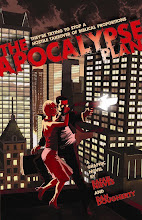Andrew Tripp, a contributor to Graven Images: Religion in Comic Books and Graphic Novels, has written an essay for STHConnect (STH = School of Theology at Boston University) on how superheroes and their film adventures may reflect upon liturgy. Preaching to the choir, as it were, of those involved in Christian liturgical practice, he posits, “The structure of the cinema and the imaginative world of the superhero film offer tools for new understandings of liturgy in your congregation. […] The community participates in stories we uplift as sacred in the past through scripture and in the present through witness and testimony.” Best yet, he’s responding to readers’ comments on the piece, so have a read and lend him some thoughts.
Meanwhile, if superheroes aren’t informing the church’s preacher, they may be decorating the church: io9‘s Lauren Davis featured the artwork of Brandon Michael Barker who has been reimagining classic superhero comics covers as stained glass windows “dressed up with a touch of Christian iconography.” Rao has included Spider-Man from Amazing Fantasy #15 below, but follow the link to see more!



